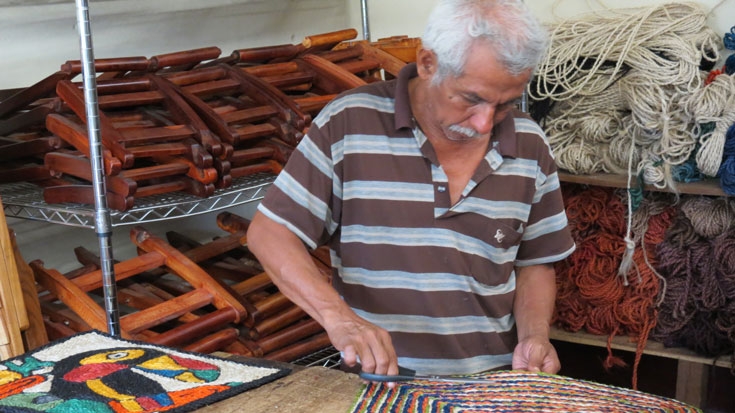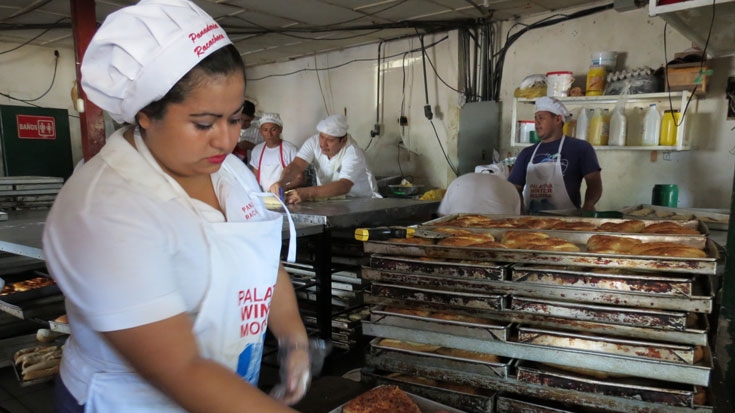Synopsis
A comprehensive approach to improving the competitiveness of MSMEs in Nicaragua—including improvements to the business environment, a matching grants program, and institutional capacity building—has led to impressive results in the creation of jobs, new products, and services, and the improvement of existing products and services.
Challenge
Nicaragua’s private sector has been dominated by micro and small businesses, with a large informal sector (estimated at 45 percent of the gross domestic product in 2002). Micro, small, and medium enterprises account for most urban jobs—74 percent of the total.
However, the poor business environment has kept many firms out of the market and raised operating costs. Moreover, Nicaraguan MSMEs lack the business skills and the kind of access to finance that would be required to be competitive. Many MSMEs were prevented from entering larger supply chains or exporting for lack of standards, both in quality and sanitary conditions.
Moreover, the business environment did not encourage improvements in standards. Health and food permits took six months and two weeks to obtain, respectively, and were only valid within Nicaragua. The processes to standardize and calibrate all types of products were unduly complex for MSMEs, hindering Nicaraguan MSMEs from trading and exporting consumable products. Worker health and safety were additional concerns for MSMEs, which often lacked the knowledge and resources to comply with such standards, thereby sacrificing potential productivity gains. Lack of knowledge about and use of patents and trademarks was preventing MSMEs from innovating and expanding their businesses.
Between 2002 and 2008, Nicaragua experienced a period of macroeconomic stability, with steady positive gross domestic product (GDP) growth, stable exchange rates, declining interest rates, and growing foreign investment. However, this was inadequate to ensure long-term economic growth and poverty alleviation, and its sustainability was not clear. Moreover, free trade agreements—such as the signing of the Central American Free Trade Agreement (CAFTA) in 2006—presented a major challenge for the private sector to grow, modernize and become more productive. For these openings to turn into economic gains and to avoid being left behind in the evolving regional trade regime, Nicaraguan MSMEs needed to improve the quality, quantity and on-time delivery of their products and services.
Solution
The solution was based on the theory that a comprehensive effort to address the constraints on the competitiveness of Nicaraguan MSMEs would contribute the most towards sustainable and inclusive growth. The Micro, Small, and Medium Enterprise Development Project therefore included activities to respond to the constraints on the competitiveness of urban MSMEs, paving the way for growth:
- Improvements to the business environment and investment climate included a reform of the almost 100 year old commercial code and the reduction in the times needed to obtain business licenses and construction permits across eight municipalities.
- The project contributed to the purchase of new equipment for the Ministry of Health (MINSA) lab, to enable it to test the safety of products. The MINSA system is now ready to be linked with other systems in Central America to facilitate the export of Nicaraguan products.
- The project provided support to the Intellectual Property Registry to improve access to patents and trademarks for MSMEs.
- A matching grants program for MSMEs to support innovation, environmental improvements, and forward and backward linkages provided US$5.56 million to 864 MSMEs. These grants were provided in five strategic productive sectors, pre-selected by the Nicaraguan government: food agribusiness, wooden furniture, clothing textiles, leather goods, and artisan products. The beneficiary MSMEs included improvement plans for worker health and safety standards.
Results
The government, the project implementation unit (PIU), and implementing agencies completed a successful project that met and exceeded nearly all targets. Enhancements to the competitiveness of MSMEs and improvements to the business environment are likely to be sustained and contribute to the overall competitiveness of the economy. The project activities improved the business environment as measured by the 2015 Doing Business report. It also improved the productivity, quality, and competitiveness of Nicaragua’s MSMEs.
- The time to start a business decreased from 39 days to 13 by project end, thanks to a full upgrade and streamlined procedures at the One-stop Shop for Investments (VUI) and the Commercial Registry.
- The time to obtain a business license declined from an average of 5.5 days across the eight municipalities, to just 0.6 days, on average, while the time to obtain a construction permit declined from 6.4 days to 1.25 days on average. These reforms coincided with an increase in the number of formally registered licenses and construction permits, thereby boosting municipal revenue and budgetary self-reliance.
- The 2015 Subnational Doing Business report on Central America and the Dominican Republic ranked the municipality of Leon number one in terms of ease of obtaining construction permits.
- Health and food permit processing times decreased from six months to 2.5 months and from two weeks to 10 days, respectively. Since the reduction in time, MINSA has issued 180 new health and food permits, facilitating the ability of MSMEs to trade and export their products.
- The Nicaraguan Ministry of Labor (MITRAB) trained 279 MSMEs in good worker health and safety standards. These MSMEs are expected to reduce absenteeism and worker turnover, improve worker morale, and thereby increase their productivity.
- The beneficiary MSMEs created 1,196 permanent jobs (on average 1.4 jobs per firm) and 351 temporary jobs; 469 firms (54 percent) introduced 736new products or processes; 628 (73 percent) improved their products or processes; and 617 firms (71 percent) increased sales. Among the firms that increased their sales during project support, the average rise in nominal monthly sales was 165 percent.
- The project improved the competitiveness of 864 beneficiary firms—or 9.3 percent of all the MSME firms that have a minimum level of formalization as of 2014.
- The number of trademarks registered annually tripled from about 3,000 in 2010 to more than 10,000 in 2014; and the number of MSMEs registering their brands jumped from just 26 in 2010 up to 1,196 in 2014.
- Project activities improved the institutional capacity of the Ministerio de Fomento, Industria y Comercio (MIFIC) and the Ministerio de Economía Familiar, Comunitaria, Cooperativa y Asociativa (MEFCCA). Both ministries enhanced their capacities to implement World Bank projects. Also, MIFIC improved its understanding of private sector needs, as well as its capacity as a project coordinator and technical and strategic leader for private sector development.
Bank Group Contribution
The Bank supported the project with a credit of US$11.4 million equivalent (SDR 8.24 million).
Partners
The key ministries responsible for implementing the project were the Ministry of Familial, Community, Cooperative and Associative Economy (Ministerio de Economía Familiar, Comunitaria, Cooperativa y Asociativa, MEFCCA), and the Ministry of Development, Industry, and Commerce (Ministerio de Fomento, Industria y Comercio, MIFIC). These ministries and the Ministry of Finance were also very supportive of the project objective and made significant efforts towards its success.
The PIU leveraged resources within MIFIC, such as environmental specialists, to build their team. They ensured that the design was inclusive, conducting extensive stakeholder consultations and obtaining beneficiary feedback throughout the project. They also ensured strong coordination among parallel donor efforts. For example, the VUI was supported by both the Inter-American Development Bank (IDB) and the European Union in complementary aspects to the support provided by this project, and there was no overlap. Moreover, the PIU very successfully coordinated among 14 different agencies, including government agencies, the commercial registry and VUI, and municipalities.
Moving Forward
The Bank and the government have discussed options for future activities, but there are no plans at the moment for a follow-on project, either from the Bank or other donors. However, by modernizing production processes, Nicaraguan firms will be able to take full advantage of the opportunities of free trade agreements, becoming more sustainable. Technically sound business plans and profitable activities will enable firms to gain better access to financing to invest in equipment and other physical assets. Improvements in the business and investment climate supported by the project will reduce the time that managers spend on permit and asset registry processes, enabling them to focus on the challenges of new processes and practices. To maintain the equipment and systems provided by the project, the Commercial Registry has set up a dedicated IT team. The Intellectual Property Agency (RPI) has opened a window of access and communication to MSMEs. This has secured an additional source of (currently growing) revenues for the RPI. Similarly, the support to facilitate transactions at the Commercial Registry and One-Stop Shop has provided the agencies extended access to the MSME population and possibly afforded them an additional stream of revenue.
Beneficiaries
The main beneficiaries of the project were Nicaraguan MSMEs. Additional beneficiaries included other Nicaraguan firms and selected direct beneficiaries of project support within the Government of Nicaragua—the Commercial Registry of Managua, the VUI, the Intellectual Property Registry, the Ministry of Health, the Ministry of Labor, the National Laboratory of Measurements, the Ministry of Family, Communitarian and Cooperative Economy, the Ministry of Development, Industry and Commerce, and nine municipalities. The program also benefited Nicaragua’s minorities from the Creole, Miskito, Mayangna, Rama, Mozonte and Monimbó indigenous populations including those in remote areas on the Northern Atlantic coast. While together these groups comprise just 14 percent of the population, their over-representation in this program was important as they tend to suffer disproportionally from poverty and unemployment.
Geographically, beneficiaries were located in 10 administrative departments and two regions, which together represented 71 percent of the country. The majority of the 864 beneficiary firms were led by women (55 percent) and 319 permanent and 126 temporary jobs were created for women by the 459 firms in the project’s third phase. This is important, given that labor market participation for women has been much lower than for men. The impact of the overall project has been underscored by numerous press articles in Nicaragua. In one of these, a beneficiary of the program noted how her bakery business grew as a result of project support: “Before, we only used one bushel of flour. Now we use quintals.” Another article mentioned that the support provided was a “momentous step” for the five targeted sectors.


